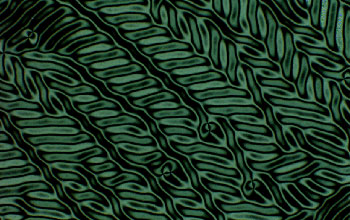Multimedia Gallery
Thin nematic film (0.4 micrometer) placed onto isotropic substrate.
Thin nematic film (0.4 micrometer) placed onto an isotropic substrate.
More about this Image
Polarizing microscope texture of a thin, liquid crystalline film. This periodic stripe structure with two different periodicities and different directions occurs in a nematic fluid, the simplest form of a liquid crystal. The nematic film is spread over the surface of an isotropic fluid (glycerine). The upper surface is free (in contact with air). In the nematic, the rod-like elongated molecules are free to move around, but they try to remain parallel to each other. The average direction of orientation is called the director. The director is distorted in the vertical plane, as the nematic-air interface favors normal (perpendicular) orientation and the glycerine-nematic interface favors tangential (parallel) orientation. When the film is very thin--less than 1 micrometer--these distortions use too much energy and the system relaxes through the periodic pattern of in-plane director variations. The effect is similar to buckling instability of an elastic rod stressed at two ends; at some critical stress, the rod bulges.
This image was created by Oleg D. Lavrentovich, director of the Liquid Crystal Institute and professor of chemical physics in the Chemical Physics Interdisciplinary Program at Kent State University. The complex, 3-D molecular arrangements in liquid crystals and other soft materials reflect a rich variety of physical mechanisms that represent the focus of Lavrentovich's research.
Recent research in Lavrentovich's lab (supported by National Science Foundation grants DMR 05-04515, DMR 07-10544 and DMR 09-06751), explore what the physical mechanisms are behind the complex, 3-D molecular architectures; what controls the molecular order in space; and what controls the time dynamics of this order. The goal is to learn how to construct self-assembled complex materials with unique structural, electric and optical properties. Liquid crystals have already been a technological revolution through their liquid crystal displays, and much more is on the horizon of current knowledge if we were to explore and utilize more complex molecular arrangements than those in these displays. (Date of Image: exact date unknown)
Credit: Oleg Lavrentovich, Liquid Crystal Institute, Kent State University
Images and other media in the National Science Foundation Multimedia Gallery are available for use in print and electronic material by NSF employees, members of the media, university staff, teachers and the general public. All media in the gallery are intended for personal, educational and nonprofit/non-commercial use only.
Images credited to the National Science Foundation, a federal agency, are in the public domain. The images were created by employees of the United States Government as part of their official duties or prepared by contractors as "works for hire" for NSF. You may freely use NSF-credited images and, at your discretion, credit NSF with a "Courtesy: National Science Foundation" notation.
Additional information about general usage can be found in Conditions.
Also Available:
Download the high-resolution TIF version of the image. (1.1 MB)
Use your mouse to right-click (Mac users may need to Ctrl-click) the link above and choose the option that will save the file or target to your computer.

 All images in this series
All images in this series